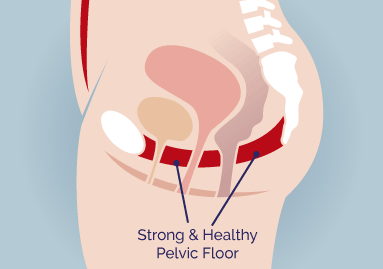Pelvic floor health in women resolves complications
We specialise in helping women with issues of incontinence (leaking urine) and pelvic organ prolapse. We do this by treating and strengthening the pelvic floor muscle. This blog aims to explain:
What is the pelvic floor?
What are the common pelvic floor conditions that women face?
What pelvic floor muscle training is trying to achieve?
How effective can you expect in physiotherapy?
What is the pelvic floor?
Your pelvic floor muscles stretch from your pubic bone (in the front) to your tailbone (in the back) and side to side between your hip bones. It essentially acts and looks like a hammock. Its role is to keep our pelvic organs sitting upwards and helps to stop the flow of urine when we aren’t ready to go to the toilet. It does this by wrapping around the urethra (urine tube) and forcing it to stop.
Common condition floor conditions women face:
Urinary incontinence
When it is weak or uncoordinated, it loses its function. Dysfunction of the pelvic floor means leakage can occur when you laugh, cough, or exercise. While there are other factors that could cause prolapse or leakage (urinary incontinence), the main cause of pelvic floor dysfunction is due to pregnancy and childbirth where overstretching of the pelvic floor occurs.
Pelvic organ prolapse
A prolapse is essentially the descent of the internal organs through the vaginal canal. In higher levels of prolapse, a heaviness or dragging sensation can be felt in the vagina. Furthermore, the prolapsed organs can obstruct the flow during urination.
Physiotherapy for the pelvic floor: what are we trying to achieve?
Women's health physiotherapy is a medical service that specifically looks into helping women with pelvic floor complications. It involves thorough assessments followed by exercise-focused intervention.
Assessment includes internal exams and measuring of pelvic floor contraction force (its ability to hold and release).
Intervention involves personalised guidance (cuing and biofeedback) to control and contract the pelvic floor. This pelvic floor muscle training aims to address prolapse and to maintain continence.
Pelvic floor muscle engagement is to be conducted in various postures and is to be incorporated into your daily routine. Note: incontinence and prolapse are not always due to weakness of the pelvic floor. The dysfunction can also be due to an over-active (tense) pelvic floor. A women’s health physiotherapist will be able to find out the reason behind the dysfunction.
How effective is the treatment in helping with leakage and prolapse?
Your program typically starts with a 1-hour initial session, with follow-ups every fortnight. In our experience, most chronic issue improves within six weeks of guided strengthening.
It is the most effective way so far proven scientifically. You can expect improvements at any age and no matter how chronic these symptoms have been (Aksac, et al. 2003).
Reference
Poświata, A., Socha, T., & Opara, J. (2014). Prevalence of Stress Urinary Incontinence in Elite Female Endurance Athletes. Journal Of Human Kinetics, 44(1), 91-96. doi: 10.2478/hukin-2014-0114
Wojno, A., Terlikowski, R.,& Knapp, P. (2014). Women's attitude towards prevention and rehabilitationof stress urinary incontinence. Progress in Health Sciences,4(1),130-135.
Aksac, B., Aki, S., Karan,A., Yalcin, O., Isikoglu, M., & Eskiyurt, N. (2003). Biofeedback and pelvicfloor exercises for the rehabilitation of urinary stress incontinence. Gynecologicand Obstetric Investigation,56(1), 23-27.
El-Hefnawy, & Wadie.(2011). Severe stress urinary incontinence: Objective analysis of riskfactors. Maturitas,68(4), 374-377.









